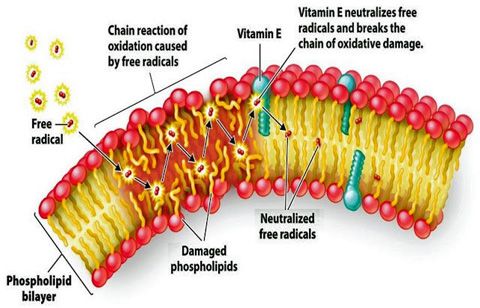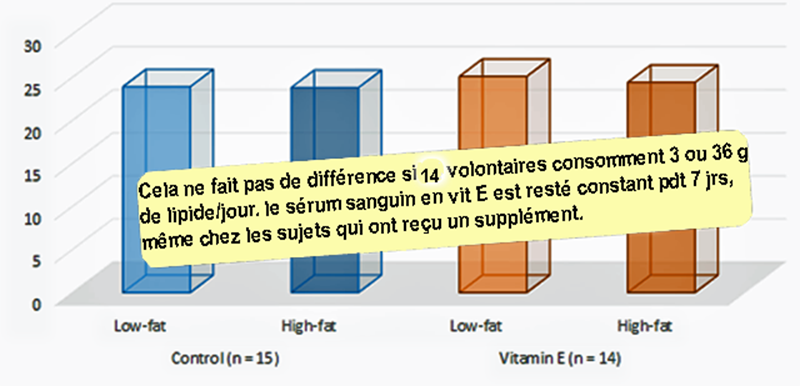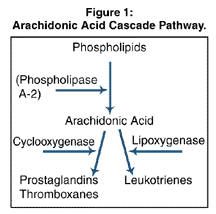How does Vit E Regulate Redox Interactions?
-
How Vit E Breaks the oxidation?
Highlights- How well does Vit E neutralize / break the oxidative damage chain reaction?
- 3 to 6 g of fat is required to assimilate vitamin E.
- Ratio 0.8 mg Vit E / 1 g fat could be optimal.
- Coconut oil interrupts the oxidative chain-reaction
- Shifting from unsaturated fats in foods to coconut oil involves several anti-stress processes, reducing the upside-down effect caused by stimulating adrenal hormones too often.
Article
We know SFA is resistant to oxidation. And Mono-unsaturated fats (from olive oil or avocado) is not particularly fragile /sensitive to oxidation because of 3 advantages: Only one double bond (unstable), two kinds of antioxidants in olive oil and very few PUFA.
Figure: Vitamin E neutralizes / breaks the oxidative damage chain reaction.

Credit: https://thenutrivore.blogspot.com/2019/05/personalizing-vitamin-e-requirements.html
*) Vitamin E requirements in relation with PUFA
If we take into account the study published in 2015, by Raederstorff, Daniel, et al. (1), the RDA intake has been set to 0.6 mg Vit E for each gram PUFA, as LA is the main omega-6. But they admit higher levels may be necessary, however, for fats that are rich in fatty acids containing more than two double bonds (e.g. ALA, omega-3). But I consider this as rather obsolete for nowadays. I’ll explain why beneath.
*) How much fat to assimilate tocopherols?
3 to 6 g of fat is required to assimilate vitamin E. To rely on topical supplementation is an option as well. Vitamin E is less sensitive to the absence of dietary fat than you think. Annet JC Roodenburg et al. indeed argue that optimal vitamin E intake requires only a “limited amount” of dietary fat (Roodenburg, 2000). (2)
If you look at the high prevalence of vitamin E deficiency among the majority of "fat-loving" people, it becomes clear that lack of dietary fat is not theoretically or practically the No. 1 reason, why these people are deficient in tocopherols and tocotrienols. The fact that the diet is rich in PUFA and that overconsumption exacerbates inflammation could explain why Mother Nature has provided certain foods with vitamin E. And we know that Vit E could be depleted when there is a lack of antioxidants. See synergy and sparing effects of Vit C on Vit E, for more details. (3) But let's leave this subject aside now.
Figure: Serum vitamin E levels

Credit: Serum vitamin E levels after 7 days of diet (low fat, 3 g or high fat (36 g) with or without vitamin E supplement (Roodenburg, 2000, American Journal of Clinical Nutrition).
*) An update should be taken into account
I try to limit my PUFA uptake to 6 g per day, rather than 10 gr; mostly coming from bread, oat and meat (duck, poultry, beef, white fish, and as little pork as possible) (Upper limit ALA 1 and LA 5).
To simplify, let’s say MUFA is neutral whenever it comes from olive oil. Linoleic acid (LA, omega-6) is considered as the primary dietary PUFA but if we take SFA at the same meal, it’s going to attenuate its susceptibility to oxidation. (4)
If we eat regularly fish twice a week, and / or some oysters or shrimps, we should upgrade the coefficient for required vitamin E. from 0.6 for 1 g fat, it could easily become 0.8.
However, we’re not going to neutralize the whole effects of PUFA like this, with a ratio 0.8, though it could make the difference between a slow metabolism (hypothyroidism) and an optimal carburation. I mean it would partially set things in the right position, one very important aspect to optimize mitochondrial respiration, on long term, since we store unused polyunsaturated fatty acids in our tissues. Anything that exceeds hormonal needs is to be considered superfluous and will accumulate in the tissues, emerging via the arachidonic cascade (pro-inflammatory), in the event of stress or injury.
Figure: AA cascade (way for Cox & Lox => inflammation prostaglandins)

To be continued on next post. -
Role of SCFA in the redox homeostasis
NB: Report from source 5.
"Short chain fatty acids (SCFAs) are a link between the microbiota, redox signaling and host metabolism". (5) Indeed, SCFAs modulate Nrf2 redox signaling through specific free fatty acid receptors. In this way, butyrate induces epigenetic regulation and/or Nrf2 nuclear translocation. Butyrate and propionate also protect the blood-brain barrier by facilitating DHA transport.
Finally, SCFAs supports regulation of redox homeostasis as potential therapeutic nutrients in health and disease.Coconut oil have an anti-oxidative effects, namely by interrupting the chain-reactions of oxidation and by reducing our needs for vitamin E. (6)
“Coconut oil that has been kept at room temperature for a year has been tested for rancidity, and showed no evidence of it. Since we would expect the small percentage of unsaturated oils naturally contained in coconut oil to become rancid, it seems that the other (saturated) oils have an anti-oxidative effect: I suspect that the dilution keeps the unstable unsaturated fat molecules spatially separated from each other, so they can’t interact in the destructive chain reactions that occur in other oils. To interrupt chain-reactions of oxidation is one of the functions of antioxidants, and it is possible that a sufficient quantity of coconut oil in the body has this function. It is well established that dietary coconut oil reduces our need for vitamin E, but I think its antioxidant role is more general than that, and that it has both direct and indirect antioxidant activities.” RP – Coconut Oil.
“While components of coconut oil have been found to have remarkable physiological effects (as antihistamines, anti-infectives / antiseptics, promoters of immunity, glucocorticoid antagonist, nontoxic anticancer agents, for example), I think it is important to avoid making any such claims for the natural coconut oil, because it very easily could be banned from the import market as a “new drug” which isn’t “approved by the FDA.” RP – Coconut Oil.
“Just as metabolism is “activated” by consumption of coconut oil, which prevents the inhibiting effect of unsaturated oils, other inhibited processes, such as clot removal and phagocytosis, will probably tend to be restored by continuing use of coconut oil.” RP – Coconut Oil.
“The ability of some of the medium chain saturated fatty acids to inhibit the liver’s formation of fat very likely synergizes with the pro-thyroid effect, in allowing energy to be used, rather than stored. When fat isn’t formed from carbohydrate, the sugar is available for use, or for storage as glycogen. Therefore, shifting from unsaturated fats in foods to coconut oil involves several anti-stress processes, reducing our need for the adrenal hormones. Decreased blood sugar is a basic signal for the release of adrenal hormones. Unsaturated oil tends to lower the blood sugar in at least three basic ways. It damages mitochondria, causing respiration to be uncoupled from energy production, meaning that fuel is burned without useful effect. It suppresses the activity of the respiratory enzyme (directly, and through its anti-thyroid actions), decreasing the respiratory production of energy. And it tends to direct carbohydrate into fat production, making both stress and obesity more probable. For those of us who use coconut oil consistently, one of the most noticeable changes is the ability to go for several hours without eating, and to feel hungry without having symptoms of hypoglycemia.” RP – Coconut Oil.
https://raypeat.com/articles/articles/coconut-oil.shtml 2012. -
Sources and References
- Raederstorff, Daniel, et al. "Vitamin E function and requirements in relation to PUFA." British Journal of Nutrition (2015): 1-10. doi: 10.1017/S000711451500272X
The reported ratio of vitamin E/PUFA of 0·4–0·6 mg RRR-α-tocopherol/g of PUFA from these studies may not be relevant for ratios with other PUFA with more than two double bonds.
=> High side of the fork: 20 mg Vit E for 10 gr PUFA. - Roodenburg, Annet JC, et al. "Amount of fat in the diet affects bioavailability of lutein esters but not of α-carotene, β-carotene, and vitamin E in humans." The American journal of clinical nutrition 71.5 (2000): 1187-1193.
- Synergy effect with vitamin E
“Vitamin C regenerates vitamin E and vitamin E protects β-carotene, helped in this by polyphenols. In the event of β-carotene supplementation, vitamin C regenerates vitamin E and β-carotene, and β-carotene seems to protect vitamin E without really explaining this phenomenon "(1)
Savings effect
Vitamin E is not just a vitamin. Vitamin C makes it possible to recycle oxidized vitamin E and thus prolong its lifespan. The same goes with glutathione which is thus saved for other more useful functions (detox). Glutathion is our antioxidant master. Vitamin E protects against the deleterious effects of polyunsaturated fatty acids when the latter are in excess. And it is quickly done! - John Libbey Eurotext - Anti-oxydants d’origine alimentaire : diversité, modes d’action anti-oxydante, interactions. Auteur : Claude Louis Léger.
- Protective role of vitamin E, by Ray PEAT.
https://raypeatexplained.com/ray-peat-on-vitamin-e/
Ray Peat says:
Iron destroys vitamin E, so vitamin E should be taken as a supplement. It shouldn't be taken at the same time as the iron-contaminated food, because iron reacts with it in the stomach. About 100 mg. per day is adequate, though our requirement increases with age, as our tissue iron stores increase.
Conversion rate:
To convert from mg to IU: 1 mg of alpha-tocopherol is equivalent to 1.49 IU.
To convert from IU to mg: 1 IU of alpha-tocopherol is equivalent to 0.67 mg.
- Short-chain fatty acids as modulators of redox signaling in health and disease
https://doi.org/10.1016/j.redox.2021.102165
- Raederstorff, Daniel, et al. "Vitamin E function and requirements in relation to PUFA." British Journal of Nutrition (2015): 1-10. doi: 10.1017/S000711451500272X
-
Additional info
*) High dose Vit K can interfere with Vit E
They are all fat-soluble vitamins and can compete with each other for absorption into the micelle. Vitamins A and E are antagonists of vitamin K because they interfere with its absorption and metabolism.
Taking a high dose Vit K2 requires transporters that are in limited amount for transport in circulating lipoproteins for subsequent uptake by tissues.
How much is too much is not clearly defined.
By the way excess Vit E, K and Q10 leaves quinones but our liver has a limited capacity to deal with.
I never take Vit A supplement at the same time as the other lipovitamins.
*) These studies found that vitamin E can block the replication/infection caused by the entire family of beta-coronaviruses (of which SARS-CoV-2 is a member)! (Posted by Haidut)
a) Water-soluble tocopherol derivatives inhibit SARS-CoV-2 RNA-dependent RNA polymerase
https://doi.org/10.1101/2021.07.13.449251
b) Water-soluble vitamin E compounds directly inhibit SARS-CoV-2 replication and synergize with remdesivir
https://www.news-medical.net/news/20210715/Water-soluble-vitamin-E-compounds-directly-inhibit-SARS-CoV-2-replication-and-synergize-with-remdesivir.aspx
=> Take 75 IU - 100 IU orally, once daily, with a meal. Since vitamin E has a half-life of about 48 hours, this dosage can even be taken every other day and still achieve the same concentrations and, hopefully, the same antiviral effects. The study also found that alpha-tocopherol (vitamin E) was about 100-fold more potent/effective than Remdesivir against SARS-CoV-2 and other coronaviruses!
Comment from Yerrag, I think:
There are not many studies on substances with direct viral replication inhibition effects against SARS-CoV-2. Glycine, naringenin, vitamin D, quinine and possibly zinc are among these substances, but it would be great if there was a substance that could both provide direct viral inhibition as well as inhibit the proliferation of the COVID-19 once infection has already occurred. Well, it appears that vitamin E is one of those substances.
https://web.archive.org/web/20140222054542/https://enerex.ca/en/articles/new-old-findings-on-unique-vitamin-e
*) Too much of a good thing is bad?
There no real danger with high dose vitamin E.
But high repeated doses of vitamin E inhibit platelet aggregation. Need to be compensate with K1.
If you are bleeding from the nose, it is because you lack vitamin K1. Beyond 800 IU of vitamin E, vitamin E is opposed to the action of vitamin K, probably because the carrier is identical.
Alpha-tocopherol is preferably stocked in the liver. (Kayden and Traber, 1993; Traber et al., 1990).
Every 72 hours would be fine with 400 UI (at least 2 toco). 20-25 UI are needed per day, according to Chris Masterjohn.More info on Vit E
https://mirzoune-ciboulette.forumactif.org/t30-vitamine-e-plus-qu-une-vitamine#60
Excerpt 1 (translator needed, in French):
Most studies show a beginning of preventive efficiency at doses of 100 IU /d in degenerative diseases. Braking of oxidative stress which is underlying the phenomena of senescence and the appearance of all degenerative pathologies: cardiovascular, cancers, osteoarthritis, osteoporosis, presbyacousis, cataract, macular degeneration, Parkinson and Alzheimer's diseases, etc…
Excerpt 2 :- Optimal contribution, without pathology, if under 40 years old: 100 IU per day.
- Contribution in case of supplementation in polyunsaturated fatty acids 100 IU per gram of EPA. - Therapeutic contribution: 400 - 500 IU every 5 days.
Mg/ UI conversion: 100 mg = 150 IU.
Personally, it’s 400 UI mixed toco every 3 days (+/ twice a week). 3x if inflammation.
Now Foods – E 400 – with mixed tocopherols. Softgels. + once a week K1 (mix K1 and K2). Vit K2 MK7 must be encapsulated (oxidation).
*) How Much and What Type of Fat Do You Need to Absorb These Fat Soluble Vitamins? Vitamin A, D, E & K
http://suppversity.blogspot.be/2014/05/vitamin-d-e-k-how-much-and-what-type-of.html*) Adjusting Vitamin E Needs with Unsaturated Oil Intake
http://www.ncbi.nlm.nih.gov/pubmed/1763554
http://libgen.org/scimag/get.php?doi=10.1007%2Fbf01610340
"...The requirement for vitamin E is closely related to the dietary intake of polyunsaturated fatty acids (PUFA). By the protective mechanism to prevent PUFA from being peroxidized, vitamin E is metabolically consumed. In addition, PUFA impair the intestinal absorption of vitamin E. Therefore PUFA generate an additional vitamin E requirement on the order of 0.6, 0.9, 1.2, 1.5, and 1.8 mg vitamin E (RRR-alpha-tocopherol-equivalents), respectively, for 1 g of dienoic (omega-7), trienoic (ALA / GLA), tetraenoic (AA), pentaenoic, and hexaenoic acid (DHA). For this reason, the gross vitamin E content of food containing PUFA does not allow an evaluation of this food as a source of vitamin E. A suitable measure is the net vitamin E content, i.e., gross vitamin E minus the amount needed for PUFA protection. Therefore, some food-stuffs generally considered as vitamin-E sources, as concluded from their gross vitamin E content, cause in reality a vitamin E deficiency if not sufficiently compensated by other vitamin E supplying food constituents. Examples of the net vitamin E content of some fats and oils, fish and nuts are shown. Consequences for food composition data and food labeling and the problem of meeting the vitamin-E requirements are discussed."
Note: The author thinks 60mg intake of vitamin E daily is not only reasonable but warranted given the net content concept and the widespread consumption of PUFA.*) Critique of the requirement for vitamin E1–3. Max K Horwitt. 2001
https://lowtoxinforum.com/attachments/am-j-clin-nutr-2001-horwitt-1003-5-pdf.1994/ (3 p.)
30 IU RDA in 1968 was halved by the next RDA Committee in 1989. The mean consumption of vitamin E by American men and women is 21.4 (± 7.2) and 16.5 (± 7.0) mol/d, respectively.
Note: As the mechanism by which phylloquinone (K1) is converted to K2 MK-4 is unknown, we cannot readily speculate how vitamin E supplementation influences the concentrations of these forms of vitamin K in extrahepatic tissue. While it is plausible that less MK-4 is produced because vitamin E supplementation reduces phylloquinone as a substrate in the extrahepatic tissue, vitamin E may also decrease MK-4 concentrations independently of phylloquinone.
NB: Vit E and K use the same transporter. So don’t take these supplements at the same time.*) Besoins en AGPI? (Needs in PUFA?)
Les besoins réels en AG polyinsaturés surestimés ? (Real needs in PUFAs are over-exaggerated)
https://mirzoune-ciboulette.forumactif.org/t1581-les-besoins-reels-en-ag-polyinsatures-surestimes#18738
=> Beneficial omega-3 intake, beyond the short term? No. Why? (In French, translator needed)
Excerpt:
“All liquid oils [rich in] PUFA, with the exception of extra virgin olive oil, are toxic, [because in excess] and can cause hypothyroidism, inhibit the immune system, be involved in heart disease , cancer, diabetes, seizures, cysts, age spots and poor digestion. This includes all oils that are liquid at room temperature, except extra virgin olive oil. » Rita Lee, PhD.
“Anything that damages mitochondria affects energy production and the production of protective steroid hormones. » Ray Peat, PhD.